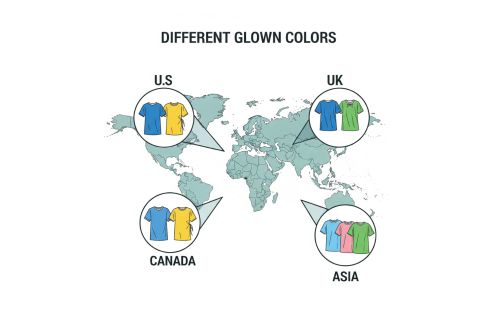
You'll Learn
- Hospital Gown Color Meaning for Patients
- 1. Decoding Hospital Gown Colors Meaning
- 2. What Hospital Gown Colors Signify (By Color)
- 3. Why Are Hospital Gowns Colored Differently?
- 4. Do Gown Colors Reflect Patient Risk or Hospital Roles?
- 5. How Hospitals Choose Gown Colors for Patients
- Gown Color Systems Around the World
- FAQs: Hospital Gown Colors Meaning
- Understanding Gown Color Codes in Healthcare
Hospital Gown Color Meaning for Patients
You've likely seen hospital gowns in different colors—blue, green, yellow, even purple—and wondered, "Does the color actually mean something?" The short answer is yes. The hospital gown colors meaning goes far beyond just aesthetics. These colors play a vital role and often carry important signals about a patient's condition, hospital role, or even infection status.

Hospital gown colors carry important meaning beyond aesthetics. Each color helps communicate a patient’s condition, status, or care needs. Whether you're a patient, healthcare worker, or caregiver, understanding these signals can enhance safety and improve the overall healthcare experience.
These gowns aren’t merely fabric—they represent a critical part of patient care protocols. From general wards and surgical procedures to isolation wards and emergency rooms, color-coded hospital attire serves as a visual language in a healthcare facility. They guide healthcare personnel in quickly identifying patient status, applying appropriate levels of protection, and ensuring efficient staff workflow. With today’s emphasis on patient care quality and efficient healthcare facility operations, the significance of gown color coding is only increasing.
Curious what the colors really stand for? Watch this short video breakdown before reading on.
1. Decoding Hospital Gown Colors Meaning

At first glance, a hospital gown might just look like a simple garment. But within healthcare facilities, it plays a significant role in streamlining communication, supporting infection control, and enhancing patient well-being.
The hospital gown colors meaning is often determined by a hospital’s internal policy, although many institutions follow shared best practices. Protective wear colors help categorize patients based on treatment type, condition, or risk level. For example:
- Yellow gowns are used for patients under infection control precautions.
- Blue and green hospital gown are typically associated with surgical settings and sterile environments.
- Red or purple gowns might signify fall-risk or palliative care patients.
In some hospitals, gown color may even indicate dietary restrictions, psychiatric care needs, or isolation requirements for infectious disease control. The use of color-coded hospital uniforms helps healthcare workers quickly adapt to patient needs without needing to constantly refer to charts or electronic records.
Beyond color, factors like gown fit, fabric types, and closure styles (Velcro or snaps) influence functionality and patient dignity. For example, gowns designed for immobile patients offer enhanced coverage and openings for medical access. In surgical procedures, gowns often adhere to strict AAMI Level classifications, ensuring they provide adequate protection for high levels of contamination risk.
2. What Hospital Gown Colors Signify (By Color)

Color-coded patient wear is more than hospital fashion—they're essential tools for quick identification and patient safety. Here's a breakdown of what the most common colors signify in various healthcare environments:
- Blue gowns: Common in surgical settings, they reduce eye strain for healthcare workers and promote a calming effect. In high-stress medical environments, like emergency rooms or surgical suites, the color blue helps minimize visual fatigue and maintains focus during long procedures.
- Green gowns: Also used in surgical environments, green enhances visual clarity by providing contrast to red tones such as blood. This aids surgeons and medical personnel during operations and helps prevent eye fatigue.
- Yellow isolation gowns: Used in cases of infectious diseases, yellow is both attention-grabbing and a visual alert for healthcare workers to practice caution. These isolation gowns are vital in isolation wards, helping control outbreaks by preventing the spread of pathogens. They also comply with liquid barrier performance standards critical to high-risk care scenarios.
- Purple gowns: Purple has emotional significance and is often reserved for patients in hospice or palliative care. The color signals a need for empathy and specialized support, helping healthcare professionals adjust care accordingly.
- Red gowns: Red frequently signifies high-alert patients, such as those at risk of falling, undergoing emergency procedures, or requiring constant observation. The high visibility of red helps hospital medical staff prioritize attention.
In some facilities, additional hues such as gray, black, or teal are used for specific departments, like psychiatric care, maternity, or outpatient services. This expansion of the color coding system reflects the healthcare industry's growing emphasis on personalized patient care and departmental organization.
3. Why Are Hospital Gowns Colored Differently?

Hospitals choose medical garment colors for specific reasons, all of which contribute to improved patient care and operational efficiency.
Color Coding System
Here’s why the color coding system matters:
- Infection Control: Certain colors are designated for use in high-risk zones like isolation wards or during treatment of infectious diseases. Yellow isolation gowns, for instance, help prevent contamination. Hospitals often segregate contaminated uniforms using the CDC’s definitive guide to laundry color‑coding, ensuring healthcare apparel from isolation wards is clearly identified for safe handling.
- Quick Identification: When hospital staff can recognize a patient’s category at a glance, they can act faster, especially in emergencies. Patient wear colors reduce verbal communication and help ensure protocols are followed immediately.
- Departmental Differentiation: Color-coded hospital gowns help differentiate between patients in various hospital departments—surgery, maternity, infectious disease, general care, etc.
- Improved Staff Workflow: In fast-paced healthcare environments, these visual cues improve staff efficiency, reduce errors, and enhance overall communication.
- Patient Dignity and Comfort: Gown design and color can influence emotional response. Muted tones may reduce anxiety, while bold hues signal urgency. Healthcare apparel now comes in soft, breathable materials that ensure comfort during long hospital stays.
Other considerations include lighting conditions in different hospital units and how certain colors perform in dim or artificial light. Hospital uniform colors are often chosen to stand out or be calm, depending on the situation—emergency rooms, surgical procedures, or routine patient care.
4. Do Gown Colors Reflect Patient Risk or Hospital Roles?

Absolutely. Colors serve as critical indicators for:
- The risk level of the patient (e.g., high contamination risk)
- The role or need for specific attention (e.g., fall risk, infection precautions)
- The type of care being delivered (e.g., surgical, palliative, emergency care)
- The department or unit a patient is assigned to (e.g., maternity, ICU, psych ward)
For example:
- In maternity wards, patients may wear soft pink gowns to reduce stress and create a welcoming, calming effect.
- Emergency departments may use bright red gowns to help hospital staff quickly identify high-priority or trauma patients.
- Psychiatric units often use medical attire with special design features (tear-resistant fabric, no drawstrings) in neutral colors for safety and discretion.
Understanding these color-coded systems allows healthcare workers to prioritize care, apply appropriate protocols, and maintain better infection control. In advanced medical facilities, electronic patient records may also flag gown colors, integrating physical and digital workflows.

Here are some real-world applications in different healthcare settings:
- Red gowns in emergency rooms may signify patients requiring urgent procedures or classified as fall-risk.
- Purple gowns are often worn by patients receiving end-of-life care, helping staff recognize the emotional and physical support needed.
- Yellow gowns in isolation wards protect both patients and healthcare personnel by acting as a barrier against pathogens.
This visual categorization ensures every healthcare worker, from nurses to physicians, immediately understands how to approach and care for each patient. It enhances patient safety by reducing delays, miscommunication, or exposure risks.
Moreover, in some healthcare facilities, color-coded staff uniforms complement healthcare apparel systems. A nurse’s scrubs might match a patient’s gown color for a specific department, adding another layer of clarity in bustling medical environments.
5. How Hospitals Choose Gown Colors for Patients

Selecting hospital apparel colors involves collaboration between medical directors, infection control teams, procurement managers, and even branding experts. Here are some of the criteria that influence gown color decisions:
- Level of Protection Needed: Gowns rated under the AAMI Level system are selected based on whether they’re used for minimal risk (routine care) or high risk (surgery or pathogen exposure). The choice between Level 1–4 gowns aligns with the FDA’s guide to medical gown barrier levels, ensuring appropriate protection for surgical, isolation, or general care settings.
- Different Medical Procedures: Different procedures require different levels of gown performance. For example, fluid-resistant gowns are crucial during surgeries or drug administration.
- Hospital Branding and Policy: Some healthcare institutions adopt consistent patient gown color schemes across locations for branding and ease of training.
- Comfort and Design: Factors such as fabric softness, breathability, ease of medical access (through Velcro or snaps), and gown length matter for patient dignity.
- Visibility for Safety: Bright colors improve visibility and reduce patient elopement or misclassification.

Modern hospital uniform design has evolved to balance medical function and patient experience. As a result, today's gowns prioritize infection control while maintaining comfort and emotional ease.
Gown Color Systems Around the World

While many hospitals share similar practices, gown color standards vary globally. Here are a few noteworthy examples:
- In the United States, color-coding is often decided by individual healthcare systems or states. Isolation gowns are typically yellow or blue, while surgical gowns are green or blue.
- In the United Kingdom, NHS hospitals may use green gowns for surgical theaters and lilac or pink for general patient care.
- In parts of Asia, red gowns are sometimes used for high-alert or infectious patients, while white is avoided due to cultural associations with mourning.
- In Canada, color codes often follow the U.S. system but with regional modifications depending on climate, laundering infrastructure, and gown reusability protocols.
Understanding regional differences is key for global healthcare providers and suppliers to adapt best practices and maintain consistent patient safety measures.
FAQs: Hospital Gown Colors Meaning

What does a red hospital gown mean?
Red gowns usually identify fall-risk or emergency-status patients. They serve as a signal for increased monitoring and caution during patient care.
Who wears purple gowns in hospitals?
Patients in palliative care, memory support units, or those with mental health needs may wear purple gowns. This color prompts healthcare workers to provide attentive and specialized support.
Why do hospitals use color codes for patients?
Color codes help streamline operations, prevent contamination, and ensure faster decision-making by healthcare professionals.
Do all hospitals follow the same gown color code?
No. Hospital uniform color codes vary across facilities, but many follow national or institutional best practices, especially when tied to infection control policies.
Is there a standard color for fall-risk patients?
Red is commonly used, but bright colors like orange or yellow may also denote fall-risk patients, depending on the healthcare facility.
Understanding Gown Color Codes in Healthcare

From blue in the operating room to yellow in isolation wards, the hospital gown colors meaning extends far beyond aesthetics. These color codes serve as a critical tool for safety, communication, and dignity in modern healthcare environments.
As the healthcare industry continues to grow more complex, effective color coding systems help staff navigate various roles, patient types, and risk levels with confidence. By understanding these visual signals, we enhance patient outcomes, support emotional well-being, and foster a more efficient healthcare experience.
Whether you're a hospital staff member, a patient, or a caregiver, knowing what hospital gown colors mean empowers you to navigate the healthcare system with more clarity and care.
Interested in hospital-grade linen and PPE? Explore our hospital textile solutions to enhance patient safety and care quality.

